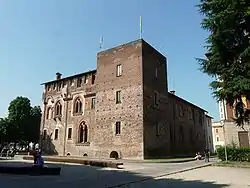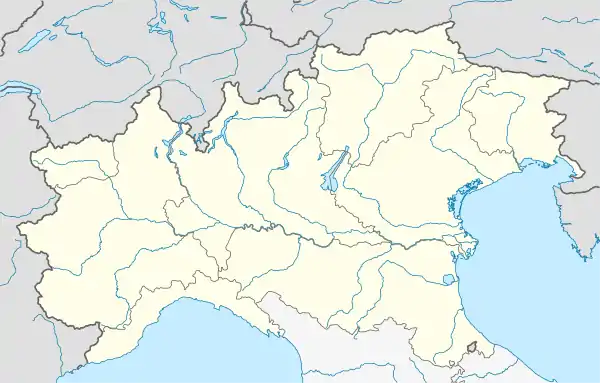Visconti Castle (Abbiategrasso)
The Visconti Castle of Abbiategrasso is a mediaeval castle located in Abbiategrasso, Lombardy, northern Italy. It lies on the Naviglio Grande axis toward Milan. From its towers the navigation along the canal could be controlled. In the 15th century it was one of the preferred residences of the dukes and duchesses of Milan.[1]
| Visconti Castle (Abbiategrasso) | |
|---|---|
Castello Visconteo di Abbiategrasso | |
| Abbiategrasso, Lombardy, Northern Italy | |
 The corner of the castle with the restored remains of the tower | |
 Visconti Castle (Abbiategrasso) | |
| Coordinates | 45°23′54″N 8°55′10″E |
| Type | Medieval castle |
| Site information | |
| Owner | Municipality of Abbiategrasso |
| Open to the public | Yes |
| Condition | Good (survived portion) |
| Site history | |
| Built | 14th century |
| Built by | Azzone Visconti, Gian Galeazzo Visconti, Filippo Maria Visconti |
| Materials | Bricks |
History
The Visconti Castle of Abbiategrasso was probably built at the end of the 13th century on the site of a previous fortification (Castro Margazario) near a Benedictine monastery. First Azzone Visconti (1329–1339), lord of Milan, and then Gian Galeazzo Visconti (1378–1402), the first duke of Milan, enlarged the castle. In 1438 it was restored and embellished by Duke Filippo Maria Visconti, son of Gian Galeazzo. Having lost any defensive function, and being easily reachable from Milan by water along the Naviglio Grande, it became his favorite country mansion.[2]
The castle had the typical Visconti castle's structure: a quadrangular layout, with an internal courtyard and portico, and four towers, one on each corner. Bricks were the primary construction material, while the stone was limited to structural or decorative elements, as the slender columns of the mullioned windows, the brackets (beccatelli), or the Biscione on the facade over the old entrance.[3][1]
To the castle had some inclination the duchesses of Milan. Here (as an alternative to Cusago) had a stable residence Agnese del Maino, mistress of Duke Filippo Maria and mother of Bianca Maria Visconti. The Sforza, dukes of Milan and descendants of Bianca Maria, favored the castle of Abbiategrasso to enhance their Visconti origins.[4]
After the Visconti-Sforza period, the castle progressively assumed the role of a stronghold again, especially during the years of the Italian Wars (1494–1559). In 1658 three towers were demolished, while the fourth was cut off. In 1862 it was sold to the Abbiategrasso municipality, which in the following years obliterated the ramparts to make space to the new train station while also taking care of some restorations.[5]
Today
Although deprived of the south wing and three towers, the castle is today in good condition and open to the public. It houses the offices and the City Council of the Abbiategrasso municipality.[1]
References
- Conti, Hybsch & Vincenti (1990), p. 34
- Del Tredici & Rossetti (2012), p. 48
- Del Tredici & Rossetti (2012), p. 50
- Del Tredici & Rossetti (2012), p. 49
- Del Tredici & Rossetti (2012), pp. 49–50
Sources
- Conti, Flavio; Hybsch, Vincenzo; Vincenti, Antonello (1990). I castelli della Lombardia. Provincie di Milano e Pavia (in Italian). Novara: Istituto Geografico de Agostini. ISBN 88-402-9108-3.
- Del Tredici, Federico; Rossetti, Edoardo (2012). Percorsi castellani: da Milano a Bellinzona: guida ai castelli del ducato (in Italian). Castelli del ducato. ISBN 9788896451021.
.svg.png.webp)